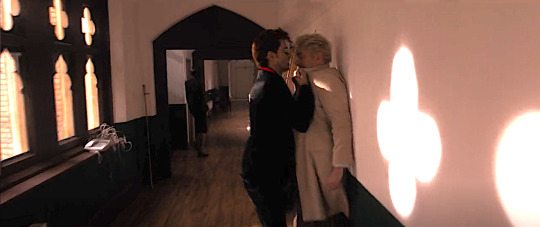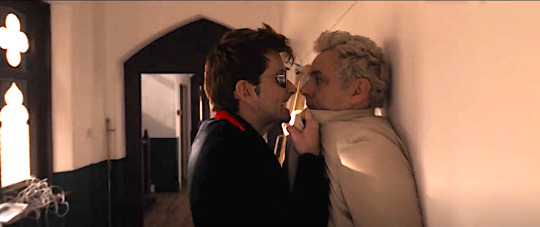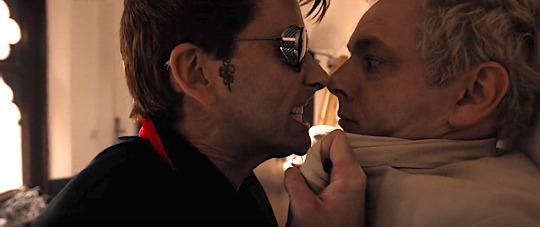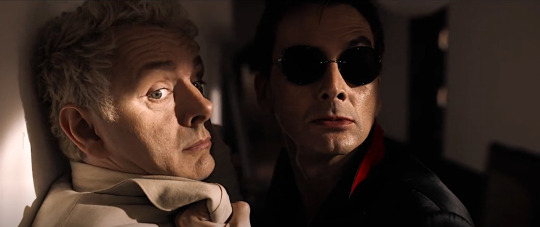#the myriad number of ways they’ve found to communicate and get close without ever actually TALKING about any of it is mind boggling
Explore tagged Tumblr posts
Text
Tracks. Also, Az’s bitchy face and tetchy little bow tie straighten in this scene is everything. Mary interrupted his whole scene 😂
Season One meta posts in 2024? Yes, very much so. We need more of that.
Will this be slightly unhinged? Yeah, probably, so welcome back to Alex's unhinged meta corner.
Everyone has probably connected the kiss back to the wall-slam scene in Tadfield Manor by now, but while I was re-watching it for the nth time and combing through it frame by frame like a mentally sane person, I realised just how orchestrated it was from beginning to end.
I assume we can agree that Aziraphale called Crowley nice on purpose to get a hint of intimacy out of him, but I think this time it is very different from the other instances during which he reacts with anger to being called nice.
My first main observation is the way Aziraphale positions himself.
We pick up after Crowley's explanation about the non-lethal shooting happening outside, and they are facing each other at an angle, with Aziraphale having stopped a few steps behind him.

Now, until the slam itself, Crowley doesn't move, he remains where he is, waiting. (We'll come back to that in a bit)
However, instead of remaining at a safe distance or standing literally standing anywhere else, he walks a small curve to then stop right in front of Crowley. Not at his side or a little bit away or at a respectable distance—no, right in his face. You can judge his position by looking at the wooden door (?) in the background.


The following camera position makes it hard to see the amount of distance between their faces, but we know that he must be close enough so that Crowley can immediately grab his coat without problem.
Excuse my art skills, but just to make sure everyone is on the same page, have a little drawing showing their positions and movements.

Now, that manoeuvring takes Aziraphale a few seconds, and what does he do? He stalls. Look at what exactly he tells Crowley:
You know, Crowley, I've always said that, deep down, you are quite a nice—
There are a lot more words than necessary! He could have shortened that sentence but he didn't, and on top of that, if you listen to him say it, he makes two noticeable pauses, one after 'Crowley with a little look outside, one after 'that'. By then he has reached his final position, so no more stalling, he can try to finish his sentence now.
Alex, you might say now, of course Aziraphale did it on purpose, but Crowley only reacted to what he said.
And to that I respond, nope, he was 100% in on it.
I know because when Aziraphale stops in front of him, he waits. He does not move, he doesn't shut him up even though he has heard the same spiel hundreds of times—no, he is waiting and allowing Aziraphale to initiate their little game.
This face is not the face of someone who is already angry or confused about which words will tumble out of Aziraphale's mouth. He even arches his eyebrow in a motion that I personally interpret as 'go on'.

Crowley is listening and waiting for the signal, and the moment Aziraphale says 'nice', he grabs him and pushes him up against the opposite wall. It's an extraordinarily quick reaction, the kind you have when you know you're about to act and what you'll do.
Some further evidence that the entire moment was orchestrated by the two of them.
Aziraphale stretches out his arms behind him to brace himself against the wall, he was expecting to be moved that way and intentionally put himself into a position that would allow Crowley to do so.


Additionally, by grabbing his lapels the way he does, Crowley can make sure that the back of his head doesn't hit the wall. If you watch the clip by yourself and slow it down, you'll discover that Aziraphale gently rests it against the wall on his own while Crowley is talking.

Aziraphale is completely relaxed not only because he knows Crowley would never hurt him, but also because this entire thing is a game that they willingly participate in. It is dangerously under-negotiated, sure; luckily they more or less agree on the ground rules.
Obligatory close-up with the noise squish because I am a blorbo connoisseur and not a heathen. The little eye gaze at the lips, and if you ask me, and this is my post so you ARE asking me, Crowley is very much looking at Aziraphale's lips from behind his glasses.

But I have one more observation to make!
I could never quite put my finger on why exactly the scene felt off, but now I am convinced it's because despite the act, Crowley isn't actually upset. There ARE times when Aziraphale actively crosses a boundary and endangers him with his compliments, but this is not one of them. The growling, him baring his teeth, the fact that he is pressing their entire bodies together, him leaning in thar far, and also what the FUCK is he saying?
The excerpt from the script books:

First part okay, I can buy that, a bit basic but alright. But 'nice is a four letter word'? Where exactly was he going with that and how was that sentence going to end? It's close enough to the topic to pass as real for any outsider who might overhear them, but if you actually listen and try to comprehend it—yeah, no, he was about to go full gibberish.
The goal wasn't to yell at Aziraphale about calling him nice, it was all about prolonging the physical intimacy by holding a monologue.
If you still don't believe me, have a look at their faces when they get interrupted.
Crowley has a "whot?" expression on his face and not a single hint of anger or annoyance. Aziraphale has an expression I will lovingly call "perish you peasant and let my demon husband slam me against a wall in peace".

If someone gave you only this picture—no context, nothing—what would you assume they were doing before someone rudely interrupted them? Based on what the fuck is happening on their faces and the complete lack of distance between their bodies, you'd probably assume they were snogging each other senseless.
Which they were, in a way, just without the lip contact.
I rest my case.
#alex talks good omens#good omens#crowley#aziraphale#good omens meta#good omens season 1#ineffable husbands#the myriad number of ways they’ve found to communicate and get close without ever actually TALKING about any of it is mind boggling#6000 years of foreplay#we all agree that there will be at the very least a power outage when they finally get down to it#right??
623 notes
·
View notes
Text
New top story from Time: Constance Woodson Worked Hard All Her Life. How Did She End Up Homeless During a Pandemic?
A few days after her 60th birthday, Constance Woodson took in the early-June sun on a bench in New York City’s Madison Square Park. Masked, except when she sipped her coffee, she reflected on her luck. The good news was that, in the midst of a pandemic, she had secured a job, as a contact tracer. She could do it from her home, with a company-issued laptop and headset. The bad news was that her current home was a room in a hotel–provided by New York City’s Department of Homeless Services (DHS)–where, she was informed, laptops were not permitted and wi-fi was not provided. Woodson had finally found a job that might get her out of her long struggle with homelessness, but she couldn’t do it, because she was homeless.
The DHS caseworkers at the Best Western Bowery Hanbee eventually told her she could bring in the laptop. But there was still the wi-fi issue, and then Woodson would have to figure out how to do a sensitive task with a roommate who liked to watch Disney cartoons day and night with the blinds drawn, and without chairs or lamps. They had been removed, she was told, because the hotel was being sold. “The system is not designed to move you forward,” she says. “I don’t want to sound like I’m complaining, but it’s been heartbreak after heartbreak.”
At last count, in 2019, more than 560,000 Americans were homeless, and 16.5% of them–about 92,000 people–were in New York State. New York City has the highest number of homeless people of any metropolitan area in the U.S., although Washington, D.C., has the highest per capita, and because of New York City’s extensive shelter system, Los Angeles has far more people living on the streets. According to the Department of Housing and Urban Development (HUD), 40% of homeless people are African American, like Woodson.
Homelessness has recently been getting worse, with a 3% increase in the number of homeless people just in the past year. But, says Nan Roman, head of the National Alliance to End Homelessness, “there’s never been anything like this.” One Columbia University analysis of unemployment figures suggested that by the end of 2020, homelessness would increase by 40%. In July, about 44.5 million Americans told the Household Pulse Survey takers at the Census Bureau that they either hadn’t made last month’s mortgage or rent payment on time or doubted they could make the next one. Unless Congress acts, the moratorium on evicting people from most federally subsidized housing will run out at the end of July. “Starting on July 25, 2020, landlords must give 30-day notice before pursuing eviction for nonpayment between March 27, 2020, and July 24, 2020,” says a HUD official. The Aspen Institute estimates that by October, 1 in 5 American renters could face eviction.
The world they will encounter is, to be generous, not very compassionate. Even before the pandemic, Woodson was kept at such distance and treated with such suspicion that she often felt as if she were contagious. In the COVID era, life for unsheltered people has gotten even more desperate. John Sheehan, director of ecumenical outreach services for Fifth Avenue Presbyterian Church in New York, who has been working among the homeless community for 40 years and who has known Woodson since 2018, says it’s not just that people have nowhere to go, no bathrooms to use, and fewer places to sleep, it’s that even the few dollars they used to get from passersby have dried up with the lack of foot traffic. “They’ve lost all the connections to the community,” says Sheehan. “I met one of my regular clients, and he said he hadn’t eaten for three days.”

Kholood Eid for TIMEWoodson holds a yoga warrior pose in Central Park on July 16
People end up with nowhere to live for myriad reasons, but there is one constant: it’s much easier to lose a home than to get a new one. Eight years ago, when her mother died after a three-year illness, Woodson discovered the family owed so much money on the home the two of them had lived in with Woodson’s daughter, Joelle, that the bank was repossessing it. Since then, her opportunities for stable housing have flattened like a slowly leaking tire. The experience has upended not only her sense of security but also her self-image. “I do not recognize this person that I have become,” says Woodson, who says at one point she briefly considered suicide. “I keep trying to figure out how I got here, what I did wrong.”
Woodson’s story is not full of dramatic mistakes. She recalls her childhood as middle-class; her father was a musician, and her mom worked in HR at the University of Missouri–Kansas City. It was, she says, “domestically turbulent”; her parents divorced when she was young, and her mother got the house. Woodson has worked most of her life, including seven years in health care administration and 13 as a manicurist at a high-end spa. In 2008, she got a degree in organizational leadership and development from Rockhurst University. With the aid of scholarships, she and her ex-husband put Joelle through Kansas City’s prestigious Pembroke Hill School, and the Rensselaer Polytechnic Institute (RPI) in New York.
But the foreclosure revealed how precarious her situation really was. By many estimates, homeownership is the most reliable wealth-building vehicle the American economic factory has ever produced. Home equity allows people to get money when they need it, which delivers them from many financial perils. It can also help them to accrue and pass along wealth. Paying off a home, however, requires not only a certain level of income but a reliable one. Otherwise, people can end up worse off than they started. Labor Department figures show that in April, on the heels of the economic shutdown, fewer than half of all African Americans were employed, the lowest rate in four decades.
In the first quarter of 2020, 74% of white people owned their homes, whereas only 44% of Black people did. This is due in part to discriminatory practices over the years that have limited Black people’s access to homes in certain areas and to mortgages, especially those at attractive interest rates. This disparity in ownership is one of the reasons that, in 2016, the median Black household wealth was $13,024 while the median white house-hold had $149,703. The loss of a home, moreover, doesn’t affect just one generation. When RPI closed its dorms for the summer, Joelle took low-paying employment as a camp counselor just to ensure a roof over her head. “What freaks me out is the fragility of everything,” Joelle says. “There’s a very thin line between having a roof and not having a roof.”
As the few jobs following the spa’s closure dried up, Woodson did what most people do when they have to move out and don’t have much money: she moved around from city to city, staying with friends or family, bartering her car for rent, dipping into her savings and petsitting. By 2016, Kansas City no longer felt like home, so she decided to join her daughter in New York. She bought a one-way ticket east, and arrived on the day Joelle graduated.
While she looked for work, Woodson bunked in with Joelle and her three roommates, but she was never able to pay much rent, and after about a year, the situation grew tense. Joelle, 26, paid for so many Airbnbs that she too began to get into financial difficulty. She still gives her mother as much money as she can spare, but she can’t afford a place for them both on her salary. “I worry about my mother every single day,” says Joelle, who works for a communications and marketing agency. “There’s a limit to what you can actually do. You hope there’s some other system that can pick up what you can’t, but there’s actually not.”
Woodson is resourceful, funny and plucky. Sheehan says she’s always advising other participants in his programs on where to find meals or a bed. She’s a client advocate at the Coalition for the Homeless. She gets SNAP food benefits ($194 a month) and keeps her Medicaid up to date, but has never been on welfare. But on March 20, when New York Governor Andrew Cuomo imposed the stay-at-home order, none of that was enough.
First, a church-run shelter Woodson used most Sundays to get a decent sleep (and where I occasionally volunteer) closed. Then the drop-in center where she sometimes scored a chair for the night halved its intake. One of her daughter’s roommates had been in contact with someone who had the virus, so Woodson couldn’t go there. The now deserted streets became an even less safe place for a woman on her own to sleep. Many of the soup kitchens closed, as they figured out how to feed people safely. Woodson, who had always resisted entering a city-run shelter, believing she was better off on her own, finally applied for a place. “I thought, I’m resilient, I’ve been through so much,” she says. “I can just do this for a few months, until I get a job.”
The DHS has helped countless people get off the streets, but Woodson found it to be illsuited to assist someone like her. Those who are the most vulnerable–physically disabled, mentally ill, addicted or formerly incarcerated–have particular programs to assist them with a place to live. Woodson is none of those things. She falls to the bottom of the list for those who need help. “They did a lot of blood tests and psych evaluations,” she says. “They looked at me, and I could tell they didn’t know what to do with me.”
At first, she was assigned to the 200-bed Casa de Cariño in the Bronx, which had just become the first shelter to have a reported case of COVID-19. (The DHS says that as of July 16, it has found 1,358 people living in shelters or on the street with COVID-19; 1,189 of them have recovered, and 103 of them have died.) Terrified, she called Joelle, who called an old friend. He had an apartment in Brooklyn that was waiting for renters who had changed their minds when the virus hit. He let Woodson stay there while it was empty.
Having a place to go to, to cook, to stay allowed Woodson to recall what it was like to be regarded as just a person walking down the street instead of a “street person.” She was not an outcast, not a problem. “It is so much better than I thought,” she said after a few weeks there. “I’m in a neighborhood. There are all sorts of people wandering around. I’m just one of them.”
By the time the landlord needed his apartment, most New York City shelter residents had been moved to hotels. The Best Western seemed clean and safe, but having tasted autonomy, Woodson found the restrictions arbitrary and cruel. The staff were overwhelmed, and she could never get in to see her case manager. She says she even got to envying her room-mate, “perfectly content watching her cartoons and stocking up on snacks.”
Just as she began to sink into despair, a family from one of the churches she went to offered her their apartment; they had moved with their five kids to Texas for the summer. All she now needed was the equipment for her new job, but having no permanent address slowed the delivery, and a month passed before she was actually working. The family’s lease is up at the end of July. As of press time, Woodson was not sure where she would go.
Perhaps if Woodson has made any mistake, it is this: She hoped for too much. She hoped for more than America was prepared to offer a Black woman who has had some run-of-the-mill setbacks. She will not settle for cartoons and free snacks. Woodson doesn’t want to be on welfare, doesn’t want to be in the shelter system, doesn’t want to just pick up jobs here and there. She wants meaningful work, independence and stability. She wants to be the one who can offer her daughter a place to stay during the pandemic.
Shopping for food at her local corner store in the Bronx, she can’t find healthy options. She wants to ask the people there: “Why do you feel like this is what we should settle for?” But she doesn’t. She just takes the long walk to Whole Foods and buys a little less. And she wants a place of her own. “I’m done with the shelter system,” Woodson says. “My plan is never to return.”
When she feels down, Woodson has two antidotes: yoga and the preacher T.D. Jakes, whom she listens to most mornings. “T.D. Jakes talks about mountains,” she says. “You can’t go around them. You have to go over them. My mom made the decision to get a reverse mortgage, and I can’t get around it.” Recently she was listening to a sermon about the beggars at the gates of Jerusalem. “I feel like that’s me,” she says. “I can see the gates, but I can’t quite get through them.”
Despite it all, Woodson retains her positive outlook. She can’t help but notice the kinds of problems she’s been wrestling with for years have emerged in other people’s lives during the pandemic. Suddenly everyone has to play by more rules; everyone is regarded with a little more suspicion; lots of people have limited access to public bathrooms. Suddenly there are many stories of men and women who face great uncertainty, worry about rent, have to think about whether there will be food that day. “People are worried about losing their houses. I know what that feels like,” she says. “It’s not, ‘Look what I’ve gone through. Welcome to my world.’ It’s that I haven’t felt so much like the outsider or the freak. I feel like now, finally, we’re all in this together–and maybe we can have a conversation.”
via https://cutslicedanddiced.wordpress.com/2018/01/24/how-to-prevent-food-from-going-to-waste
0 notes